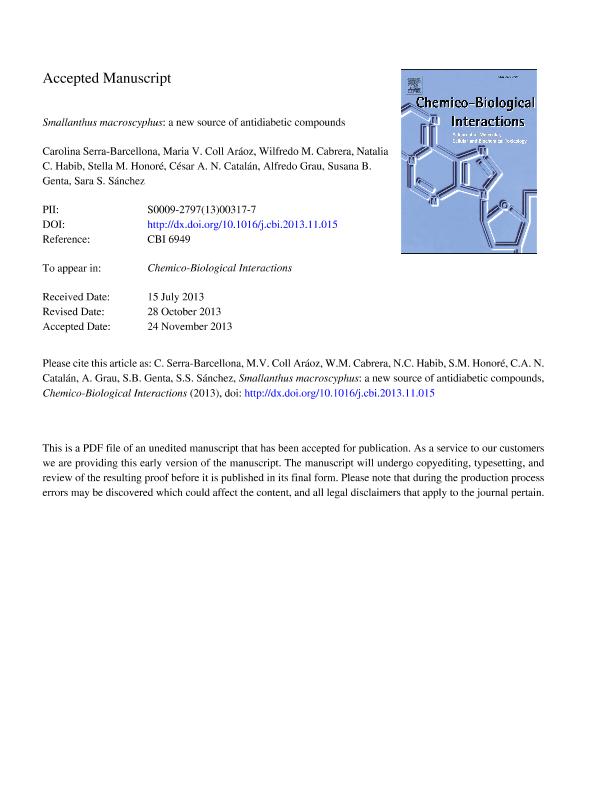Artículo
Smallanthus macroscyphus: a new source of antidiabetic compounds
Serra Barcellona, Carolina ; Coll Araoz, Maria Victoria
; Coll Araoz, Maria Victoria ; Cabrera, Wilfredo; Habib, Natalia Cecilia
; Cabrera, Wilfredo; Habib, Natalia Cecilia ; Honore, Stella Maris
; Honore, Stella Maris ; Catalan, Cesar Atilio Nazareno
; Catalan, Cesar Atilio Nazareno ; Grau, Alfredo; Genta, Susana B.; Sanchez, Sara Serafina del V.
; Grau, Alfredo; Genta, Susana B.; Sanchez, Sara Serafina del V.
 ; Coll Araoz, Maria Victoria
; Coll Araoz, Maria Victoria ; Cabrera, Wilfredo; Habib, Natalia Cecilia
; Cabrera, Wilfredo; Habib, Natalia Cecilia ; Honore, Stella Maris
; Honore, Stella Maris ; Catalan, Cesar Atilio Nazareno
; Catalan, Cesar Atilio Nazareno ; Grau, Alfredo; Genta, Susana B.; Sanchez, Sara Serafina del V.
; Grau, Alfredo; Genta, Susana B.; Sanchez, Sara Serafina del V.
Fecha de publicación:
12/2013
Editorial:
Elsevier Ireland
Revista:
Chemico-biological Interactions
ISSN:
0009-2797
Idioma:
Inglés
Tipo de recurso:
Artículo publicado
Clasificación temática:
Resumen
The aim of the present study was to analyze the in vivo hypoglycaemic effects of both decoction of Smallanthus macroscyphus leaves and pure crystalline polymatin A isolated from its leaves. Phytochemical analysis of the leaf decoction showed that its major constituents were caffeic, chlorogenic and three dicaffeoilquinic acids, together with the sesquiterpene lactone polymatin A. Oral glucose tolerance test in normal rats was performed to evaluate the hypoglycemic activity and to choose the minimum effective dose of the decoction and polymatin A. They have effective hypoglycemic activity at the minimum dose of 140 mg dry extract and 14 mg crystalline powder/kg body weight, respectively, and were selected for the following experiments. Oral administration of a single-dose of decoction produced a moderate lowering effect in fasting glycemia of normal rats, whereas polymatin A had no significant effect. We also assessed the effect of a single-dose on post-prandial blood glucose, resulting in an inhibition of the hyperglycemic peak after sucrose overload. Daily administration of decoction or polymatin A for 4 weeks produced an effective glycemic control in diabetic animals, with a decrease in urinary glucose excretion and a significant reduction in the HbA1c levels. Although there were no significant increases in plasma insulin levels, both treatments improved the fasting blood glucose/insulin ratio. In vivo acute toxicity studies were performed in adult Wistar rats. There were no deaths or signs of toxicity observed after oral administration of decoction or polymatin A at any dose level up to the highest dose tested (14.0 g /kg and 2.8 g /kg, respectively). The results presented here strongly support the notion that S. macroscyphus represents a new source of antidiabetic compounds that could help to manage diabetes more efficiently and safely.
Palabras clave:
Hypoglycemic Activity
,
Polymatin A
,
Smallanthus Macroscyphus Leaves
Archivos asociados
Licencia
Identificadores
Colecciones
Articulos(CCT - NOA SUR)
Articulos de CTRO.CIENTIFICO TECNOL.CONICET - NOA SUR
Articulos de CTRO.CIENTIFICO TECNOL.CONICET - NOA SUR
Articulos(INSIBIO)
Articulos de INST.SUP.DE INVEST.BIOLOGICAS
Articulos de INST.SUP.DE INVEST.BIOLOGICAS
Citación
Serra Barcellona, Carolina; Coll Araoz, Maria Victoria; Cabrera, Wilfredo; Habib, Natalia Cecilia; Honore, Stella Maris; et al.; Smallanthus macroscyphus: a new source of antidiabetic compounds; Elsevier Ireland; Chemico-biological Interactions; 209; 12-2013; 35-47
Compartir
Altmétricas



